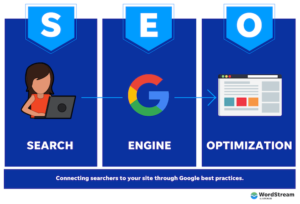Web Design is a mix of artistic creativity and technical prowess that creates digital spaces that are functional, user-friendly and aligned with strategic objectives. It involves a lot of work that includes content creation, user experience (UX) optimization, and search engine optimization (SEO).

Color can make an impact on the overall feel of a website, and can be used to reinforce brand identity. It can also be used to create contrast and draw attention to important elements. For professional help, contact Web Design The Woodlands.
A user-centric approach to web design involves understanding your customers’ needs and goals. It includes user interviews, surveys, and usability testing to understand how users interact with your site. This allows you to make informed decisions about the structure and layout of your site and how to address their problems. It also helps you create a more engaging website. This approach to web design can help you increase visitor retention and conversions.
User-centered design is an important step in the development process because it ensures that your products meet your customers’ expectations. It also reduces the cost of customer support and leads to increased sales. Unlike traditional design practices, which often prioritize aesthetics and technical specs, user-centric design puts the needs of your target audience first. It also encourages innovation and creativity, which will lead to a better experience for your visitors.
To develop a successful user-centric website, it’s important to focus on user goals and how your product will help them achieve those goals. You can find out your target audience’s goals by conducting user research, creating personas, and mapping their journey. You can also use wireframes and mockups to create a prototype of your product, which will allow you to test it with real users.
In addition, it’s essential to build a website that’s mobile-friendly. More than half of all Internet traffic comes from mobile devices, so it’s crucial to ensure your website is easy to navigate on smartphones and tablets. It’s also important to prioritize performance and speed, because users typically have short attention spans and may be frustrated by slow websites.
A successful UCD web design will provide a great user experience and engage your visitors. This will lead to higher conversion rates, which will boost your bottom line. By focusing on the needs of your visitors, you can create a more effective and engaging website that will result in more revenue for your business. Incorporating user feedback at every stage of the design process will ensure that your website will be successful for your target audience. It will also help you avoid costly mistakes that could damage your brand reputation.
Visual aspect
A website’s visual aspect is important for conveying information and attracting visitors. This includes the use of color, contrast, layout, typography, and images. The design should also be consistent across multiple devices. It should also align with the brand’s identity and goals. For example, a site’s homepage should clearly communicate the product or service and offer a clear call to action. Lastly, the website should be aesthetically pleasing and scalable for different screen sizes.
Visual hierarchy is the process of arranging elements on a webpage in a way that shows which ones are more important. It is a critical part of web design and should be carefully considered to avoid confusion for users. It is especially crucial for websites that contain a lot of information.
In addition to enhancing the user experience, visual aspect is essential for creating a website that will rank well in search engine results. It is also important for retaining visitors and increasing engagement on a website. A site with a poor visual aspect will be difficult to navigate, which can frustrate users and cause them to leave the page.
One way to improve the visual aspect of a website is by using consistent fonts and colors throughout the site. This will create a cohesive look and ensure that the user’s eye is drawn to the most important elements on the page. Additionally, avoiding overuse of visual elements such as animations or transitions will help improve the speed and performance of your site.
A high-performance website is critical to a successful business online. A site with a slow loading time will lose visitors and increase its bounce rate. It is recommended that the site should load in 3 seconds or less to be competitive. In addition, the site should have a responsive layout to ensure that it works well on mobile devices. If you want your site to perform at its best, it is necessary to choose a web hosting service that offers fast servers. In addition to being able to host your site on fast servers, the web hosting company should also provide technical support and maintenance services.
Layout of content
The layout of content is a vital aspect in web design. The best designs use white space to highlight the most important elements, but they also avoid overcrowding or overwhelming the user with too much information. In addition, a well-organized layout helps users find the content they need, increasing their chances of conversion.
There are many different types of layouts, each with its own benefits and disadvantages. For example, a one-page layout combines all content into a single scrolling page. This is ideal for websites that showcase work or products. It also reduces the number of clicks and increases user engagement.
Another popular layout is a grid layout, which organizes content into uniform blocks of similar sizes. This type of layout is often used for blog posts and social media feeds. The grid can be either uniform, with each cell having the same size, or fluid, with different-sized content in orderly columns without distinct rows (like Toptal Design’s homepage). Card-style layouts are also a good choice for content-heavy sites. These layouts resemble physical cards and allow you to add bite-sized previews of content, which encourages viewers to click and learn more.
It is also important to consider how your content will appear on a mobile device. According to HubSpot, mobile-friendly websites are more likely to convert. A mobile-friendly website should be easy to navigate and include key features like a header, footer, navigation menu, and contact information. It should also have a search bar that is easily accessible and clearly labeled.
Layouts can also help increase a website’s SEO. By using the right keywords and keeping your content updated, you can attract more customers. However, be careful not to overdo it, as unnecessary keyword stuffing can negatively impact your site’s search engine ranking.
It is important to test your layout with real people. This way, you can avoid errors and get feedback before launching your site. It is also a good idea to keep an eye on user trends and needs. This will enable you to make changes and updates quickly and effectively.
Process
A great website starts with a solid design process. Without one, you can get caught up in a cycle of endless revisions. In addition, a website’s success depends on the overall user experience and the effectiveness of its content. This requires a clear and effective process for communicating with stakeholders. Whether your team uses agile or waterfall methodologies, it is essential to create a feedback loop that is free from confusion and misunderstandings. This will help you deliver a product that meets your client’s expectations.
The first step in the web design process is planning and conceptualization. This includes understanding your project goals and creating a sitemap that outlines the structure of your website. During this phase, you can also sketch some low-fidelity designs to get creative and record your ideas. This is often known as wireframing, and it involves designing very simple page sketches that focus on the layout and basic elements. These sketches are usually black and white, and they include placeholders for content to be added later.
Another vital aspect of the web design process is defining your website’s visual language. The choice of color, fonts, and images can make a huge difference in the user’s experience. This is why it is important to research your competitors and understand what works for them. Then, you can create a unique and visually appealing design that is tailored to your target audience.
Once you have a firm grasp on your visual style, it’s time to start building the website. This is when you’ll need to know what technologies and tools to use. This includes HTML, CSS, and JavaScript. These are the tools that enable you to build a webpage that will work across different devices and browsers.
When you’ve finished designing your website, it’s time for testing. This includes server-side testing (where the developers place the finished website on a production server for internal audiences), as well as browser and device testing. This will identify any unforeseen issues that need to be addressed before the website goes live. It is important to communicate with your team and clients throughout the entire design process. This will allow for quicker feedback and a more seamless workflow. It will also help you to meet your deadlines and avoid costly changes down the road.

